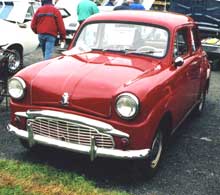Except for avid bikers, to most Americans the word “Triumph” calls to mind a nifty little TR-2, 3, 4 or 6. (There was no TR-5 here; our version of the six-cylinder TR-4 was the carbureted TR-250.)
In fact, the name was seldom found on ordinary passenger cars.Even in the cars’ British homeland, the company’s name “Standard” being used instead. Notable exceptions were the 1800 and 2000 roadsters of 1946-49, with their twin dickie (rumble) seats with pop-up windscreen, and the razor edge Renown saloon. A small razor edge, the Mayflower, was developed with Americans in mind, but they minded very much and bought few, though a convertible version might have helped.
With the success of the sports cars in America and the boom of imports in 1958, the Standard Triumph Motor Company decided to try sedans and station wagons here, selling versions of the Standard Ten as the Triumph Sedan and Triumph Estate. It was an attractive little car, of unibody construction and powered by a 948 cc four that owed much to the “big TRs” engine. That fact was TR-2much touted in the TR-2literature, in which the sporting sibling was usually featured. The interior was pretty basic, and the seating, despite the claims, was not very comfortable. I can tell you from experience that the old folks in this illustration are really pretty cramped, and that poor child in the back is romping around unrestrained, without even a seat to sit on. Later, the company started to call it the Triumph Ten, then finally the TR-10, but despite (or because of) some pretty dismal advertising the car never caught on.
I hadn’t realized it, but some Americans had seen the car before. The New York dealer, Fergus Motors, had offered a “Vanguard Cadet” in the mid-1950s that was a rebadged Standard Eight, predecessor of the Ten. “Vanguard” was the name of the larger Standard sedan, also sold here, apparently, along with the Renown.
After a couple of years the Ten was succeeded by the Triumph Herald, a modest success, which begat the small sports Spitfire, a competitor to the Austin-Healey Sprite and a success story of its own. There was a brief attempt to market a larger sedan here, the 2000, in the mid-1960s, probably in response to the Rover 2000TC sports sedan, but despite a six-cylinder engine and a TC version of its own, the 2000 soon retreated to its homeland.
In Britain, meanwhile, the heir apparent to the Herald, the 1300, had been born. Of front-wheel drive design and with an engine of that cubic capacity, the 1300 was a lively little car, and handled well – Jill’s Mum had one and I liked it very much.
Standard-Triumph, and successor British Leyland, got a lot of mileage out of that 1300 shell. It was upgraded to 1500 power, then converted to rear-wheel drive as the cheaper Toledo. In 1972, with more upmarket appointments, it became the Dolomite. Sumptuous seats, wood dashboard and available automatic transmission added convenience and prestige, and a new 1850 cc slant four engine, cousin to the Saab 99 powerplant, gave more power. My mother-in-law had several of these, good cars generally. She really liked the wood dashboards.
The ultimate Dolomite was the 16-valve sohc Sprint, built through 1980. The final Triumph sedan was the Acclaim, based on the Honda Ballade, in turn related to the second-generation Civic. Many people claim it was no Triumph at all.
My father had a 1960 Triumph Ten Estate. He ran a small printing business, and the convenient cargo capability of the Triumph was a great asset. It ran well enough, but it rusted badly. Eventually he pushed it under the barn. About 15 years later, I located a Canadian collector who wanted it, so we exhumed it and three generations of Fosters got it ready to travel. I assume it made it to Ontario, but I’ve never heard if the ambitious restoration the fellow planned ever took place.

